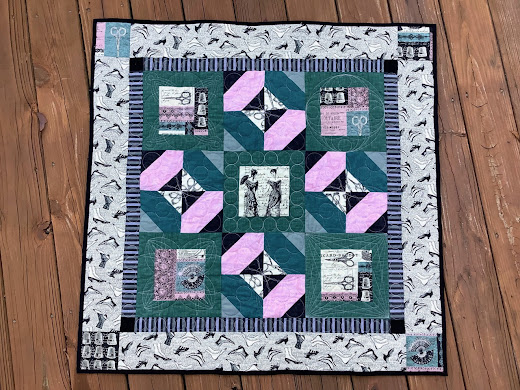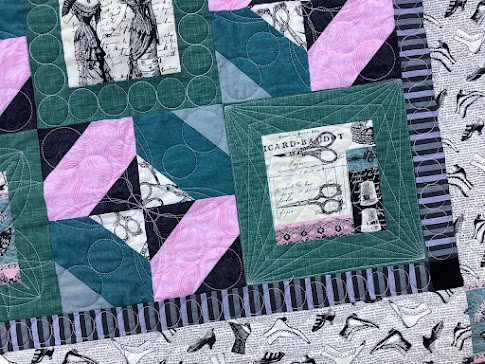When I teach my Intro to Free-motion Quilting workshop, one of the items included on the Student Supply List is a sketchbook. Yes, a sketchbook! It serves multiple purposes and many of the students at a recent class mentioned this was a valuable tool and an important take-away from the class.
.jpg) |
| Drawing free-motion quilting designs in a sketchbook. |
Where to get a sketchbook?
I always advocate supporting and buying from your local quilt shop or online with any of the thousands of independent quilt shops across the country for purchasing your quiltmaking supplies. A sketchbook, however, is one of the very few items you get a "pass" on if you don't buy it at the local quilt shop. Check your local craft/hobby store or an online art supply store and get a sketchbook with 50 to 100 pages.
Note: use the craft store's coupon to purchase the sketchbook, then apply the savings to buy more fabric at the quilt shop.
What kind of sketchbook?
Get a sketchbook specified for drawing. The pages will be a soft white color. The paper will have a nice, smooth finish, and will easily take marks from dry drawing media—pencil, pen, gel pens, etc. Generally, the paper weight is from 65 lb/96 gsm to 80 lb/130 gsm and 90 lb/160 gsm for a sheet that is slightly heavier and more opaque.
 |
| Jackie at Intro to Free-motion Quilting at John C. Campbell Folk School. |
I prefer a spiral bound (wire bound) sketchbook so the sketchbook lies flat when drawing. The spiral keeps the pages bound together for future reference. However, many spiral bound sketchbooks also have a perforation on each page should a page need to be removed for some reason.
 |
| A sketchbook page filled with free-motion motifs. |
What size sketchbook?
I recommend a sketchbook that is at least 14" x 17". Why? Because you'll find there are a LOT of quilt blocks that are 12" so a larger sheet of paper will accommodate this popular block size.
 |
Karen (left) and Karen (right) at Intro to Free-motion Quilting
at John C. Campbell Folk School.
|
What goes in the sketchbook?
In class, my students start with simple drawing exercises—drawing basic free-motion quilting [FMQ] shapes.
 |
Katy (left) and Wendy (right) at Intro to Free-motion Quilting
at John C. Campbell Folk School.
|
After drawing and quilting the basic shapes on practice quilt sandwiches, we work through designs that can be used as edge-to-edge, all-over quilting patterns, and background fillers.
 |
Diane (left) and Kathie (right) at Intro to Free-motion Quilting
at John C. Campbell Folk School.
|
Where do you find new FMQ designs?
In search of new ideas for free-motion quilting designs? Use the motifs and designs from your fabrics as a reference. In a recent workshop at the John C. Campbell Folk School, students received complimentary fat quarters from Art Gallery Fabrics as inspiration for developing motifs and continuous line patterns for their free-motion practice.
 |
Dina at Intro to Free-motion Quilting at John C. Campbell Folk School.
|
 |
| Kathy at Intro to Free-motion Quilting at John C. Campbell Folk School. |
Keep that sketchbook handy... and use it!
Use your sketchbook as an on-going FMQ reference book! It's a resource and tool for:
- learning shapes and paths for new (or new-to-you) designs
- auditioning different designs for quilt blocks, sashings, and borders
- creating new designs
- getting familiar with a design and its path before going to the sewing machine
- exercising muscle memory
- developing your repertoire of potential quilting patterns for current and future quilts.
And if you don't like a design, or you think you made a "mistake" in your sketchbook, you don't have to pick out any stitches!
Remember, your sketchbook is YOUR sketchbook. It doesn't have to be pretty. It doesn't have to be "perfect." You don't have to show it to anyone if you don't want to. It's a work-in-progress... a reference tool for your FMQ practice.






















.jpg)






